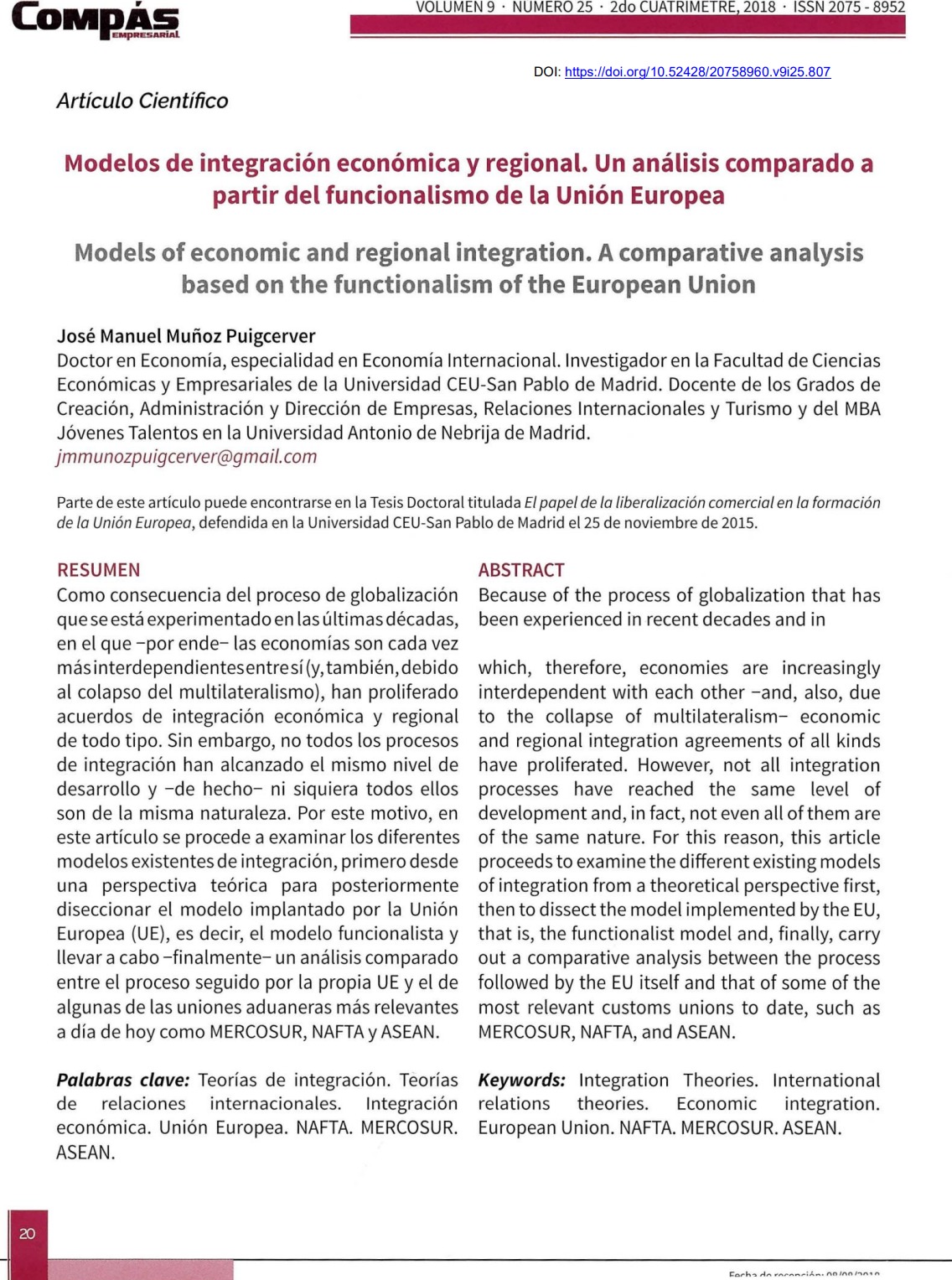Models of Economic and Regional Integration. A Comparative Analysis Based on the Functionalism of the European Union
DOI:
https://doi.org/10.52428/20758960.v9i25.807Keywords:
lntegration Theories, lnternational relations theories, Economic integration, European Union, NAFTA, MERCOSUR, ASEANAbstract
Because of the process of globalization that has been experienced in recent decades and in which, therefore, economies are increasingly interdependent with each other -and, also, due to the collapse of multilateralism- economic and regional integration agreements of ali kinds have proliferated. However, not ali integration processes have reached the same level of development and, in fact, not even ali of them are of the same nature. For this reason, this article proceeds to examine the different existing models of integration from a theoretical perspective first, then to dissect the model implemented by the EU, that is, the functionalist model and, finally, carry out a comparative analysis between the process followed by the EU itself and that of sorne of the most relevant customs unions to date, such as MERCOSUR, NAFTA, and ASEAN.
Downloads
References
(1) Arta[ A. (2002). El proceso de integración económica regional del cono sudamericano. Colombia: Departamento de Economía, Universidad Politécnica de Cartagena.
(2) Bielschowsky, R. (2009). Sesenta años de la CE PAL: estructuralismo y neoestructuralismo. Revista Cepa[, 97. Santiago de Chile: Editorial CEPAL. https://doi.org/10.18356/da9c4c43-es
(3) Bustelo, P. (1999). Globalización económica, crisis financieras e integración regional: enseñanzas de Asia oriental para América Latina. Revista de Economía Mundial. España: Sociedad de Economía Mundial - Servicio de Publicaciones de la Universidad de Huelva (1), p. 55-68.
(4) Fukukawa, S. (2002). Globalism and Regionalism in the Post-Doha Trading System. Estados Unidos: Department of the treasury, US office of public affairs.
(5) Hernández L. (2006). Análisis contemporáneo del proceso de integración económica regional en América Latina. Análisis económico. México: Universidad Autónoma Metropolitana Azcapotzalco. Primer Cuatrimestre, 21(046): 291-305.
(6) Hirst M. (2004). La fragmentada agenda de (in)seguridad regional. En Hirst, Mónica - Pérez Llana, Carlos - Russel, Roberto - Tokatlián, Juan Gabriel. Imperio, Estados e Instituciones. La política internacional en los comienzos del siglo XXI. Bolivia: Fundación Friedrich Ebert - Instituto Latinoamericano de Investigaciones Sociales (FES - ILDIS). p. 99-146. ·
(7) lbarra G. (2008). El auge del bilateralismo en las relaciones comerciales internacionales, en Obra en homenaje a Rodolfo Cruz Miramontes. México: Biblioteca Jurídica Virtual del Instituto de Investigaciones Jurídicas de la UNAM.
(8) Mckay J, Armengol O y Pineau G. (2004). Regional economic integration in a global framework. Alemania: European Central Bank.
(9) Muñoz H. (2006). ¿El fin de América Latina? Foreign Affairs en español. México: Council on Foreign Relations (CFR) e Instituto Tecnológico Autónomo de México (ITAM).
(10) Russel R. yTokatlián JG. (2004). Argentina, Brasil y EE. UU: El desafío de una esfera de cooperación. Perú: Instituto de Estudios Internacionales (IDEI) Revista Agenda Internacional. (2) p. 16-30.
(11) Sapir A. (2011). European lntegration atthe Crossroads: A Review Essay on the 50th Anniversary of Bela Balassa's Theory of Economic lntegration. Estados Unidos: American Economic Association. Journal of Economic Literature. 49 (4): 1200-1229. https://doi.org/10.1257/jel.49.4.1200
(12) Severino RC. (2006): Integración económica regional en Asia-Pacífico: la experiencia de ASEAN. España: Casa Asia, Fundación CIDOB, Real Instituto Elcano. Anuario Asia-Pacífico, p. 301-309.
(13) Stiglitz, J. (2006), Cómo hacer que funcione la globalización. Madrid, España: Tau rus.
(14) Varios (2009). Liber Amicorum. Marcelino Oreja Aguirre. Madrid, España: CEU. Instituto Universitario de Estudios Europeos. Universidad San Pablo. Editorial (interco, p. 499.

Downloads
Published
How to Cite
Issue
Section
License
Copyright (c) 2018 José Manuel Muñoz Puigcerver

This work is licensed under a Creative Commons Attribution 4.0 International License.
Authors who publish with this journal agree to the following terms:
- Authors retain copyright and grant the journal right of first publication with the work simultaneously licensed under a Creative Commons Attribution License 4.0 that allows others to share the work with an acknowledgement of the work's authorship and initial publication in this journal.
- Authors are able to enter into separate, additional contractual arrangements for the non-exclusive distribution of the journal's published version of the work (e.g., post it to an institutional repository or publish it in a book), with an acknowledgement of its initial publication in this journal.
- Authors are permitted and encouraged to post their work online (e.g., in institutional repositories or on their website) prior to and during the submission process, as it can lead to productive exchanges, as well as earlier and greater citation of published work.









